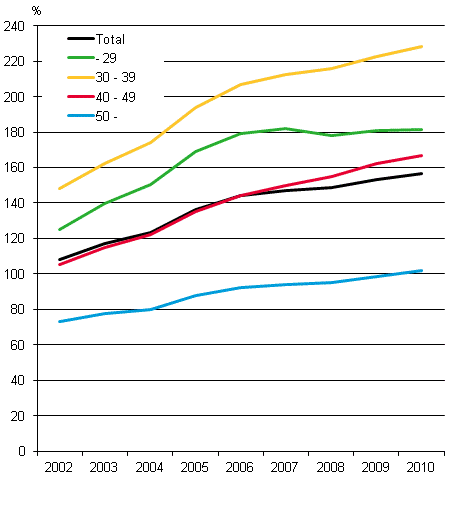Published: 20 January 2012
Debts grew more than income in 2010
During a decade, household-dwelling units’ debts have gone up by clearly more than their income. In 2010, household-dwelling units’ with debt rate of indebtedness, i.e. ratio of debts to disposable income, was 156 per cent, having been 108 per cent in 2002. In 2009, the rate of indebtedness was 153 per cent. Outstanding debts of household-dwelling units with debt grew by 4.9 per cent and their disposable monetary income by 2.6 per cent in 2010. Except for the youngest ones, household-dwelling units’ rate of indebtedness rose from the previous year in all age groups.
Rates of indebtedness of indebted household-dwelling units by age group 2002-2010, %

Housing loans grew by most and, among them, especially loans taken out for first homes. Housing loans grew by altogether 6.3 per cent and loans for first homes by 11.5 per cent. Other debts, such as loans for cars, free-time residences or general consumption, grew by less, or by just 0.5 per cent from the previous year. Loans taken out for business purposes grew by 4.6 per cent and study loans by 2.7 per cent.
There was 1 487 000 household dwelling units’ with debt in 2010. Their total debts amounted to EUR 100 billion. The amount of debt per indebted household-dwelling unit was EUR 67,260. Most, or EUR 72.3 billion, of the debts were housing loans. The amount of housing loan per household-dwelling unit with housing debt was EUR 85,600. EUR 12.2 billion of the housing loans had been raised for first homes. The average amount of housing loan for first home per indebted household-dwelling unit was EUR 80,960. Households-dwelling units in the 35 to 44 age group had the largest debts: EUR 98,970 per indebted household-dwelling unit.
However, slightly younger household-dwelling units in the 25 to 34 age group had the largest housing loans, amounting to EUR 114,550 per household-dwelling unit with housing debt. The debts of the oldest household-dwelling units grew by most in 2010: the average debts of indebted pensioner households increased by nearly 14 per cent, whereas those of under 24-year-olds decreased by one per cent. Housing loans accounted for the largest share of the debts of household-dwelling units of all ages, and their share was still nearly one-half of even the debts of pensioner households.
There were 260,840 household-dwelling units whose debts amounted to at least three times their disposable annual income. Nearly all of them had housing loans. The number of such household-dwelling units increased by 8,550 from the previous year. However, there were 760 fewer this indebted household-dwelling units in the under 25-year-old age group than in the year before. Large debts were most frequent among the household-dwelling units where the reference person was aged from 25 to 34, of which 97,900 had debts exceeding three times their annual income. The debts of one-quarter of the indebted household-dwelling units with children were equally large.
In all the examined years, housing loans have grown by more than other debts. Indeed, their share of household-dwelling units' debts has increased clearly: in 2002, the share of housing loans was 65 per cent but in 2010 already as high as 72 per cent of all debts of household-dwelling units. Over the same period, the shares of loans for business purposes and study loans have almost halved among all debts. The share of other liabilities has remained unchanged at around one-fifth of all debts.
Household-dwelling units’ interest expenses decreased by 30 per cent from the previous year. They paid EUR 2.3 billion in interests in 2010.
Source: Indebtedness 2010. Statistics Finland
Inquiries: Timo Matala (09) 1734 3422
Director in charge: Riitta Harala
- Tables
-
Tables in databases
Pick the data you need into tables, view the data as graphs, or download the data for your use.
Updated 20.1.2012
Official Statistics of Finland (OSF):
Indebtedness [e-publication].
ISSN=2489-3285. 2010. Helsinki: Statistics Finland [referred: 31.12.2025].
Access method: http://stat.fi/til/velk/2010/velk_2010_2012-01-20_tie_002_en.html

